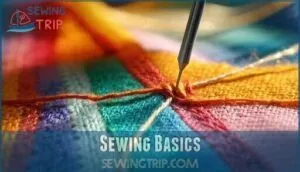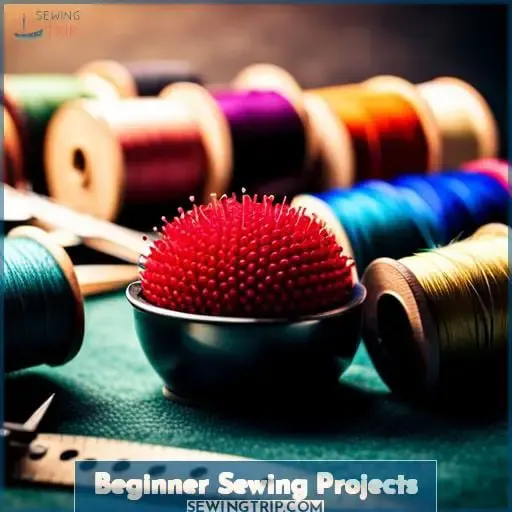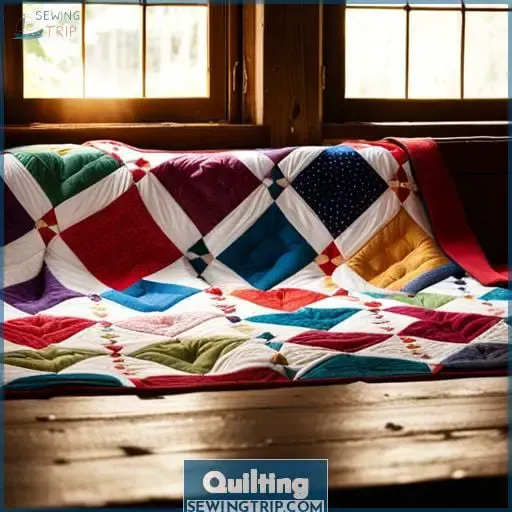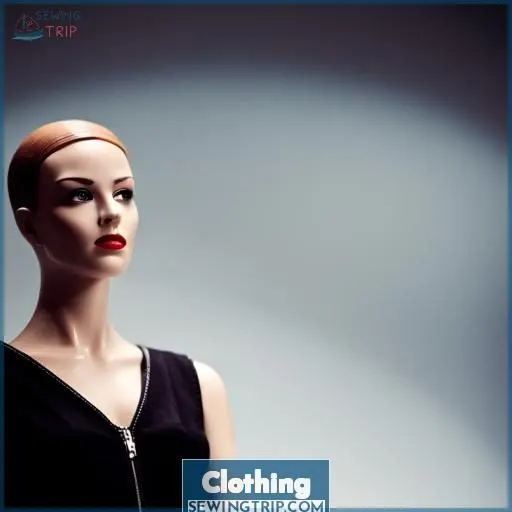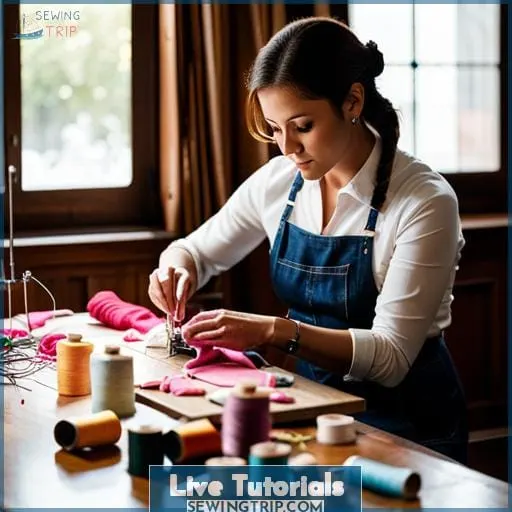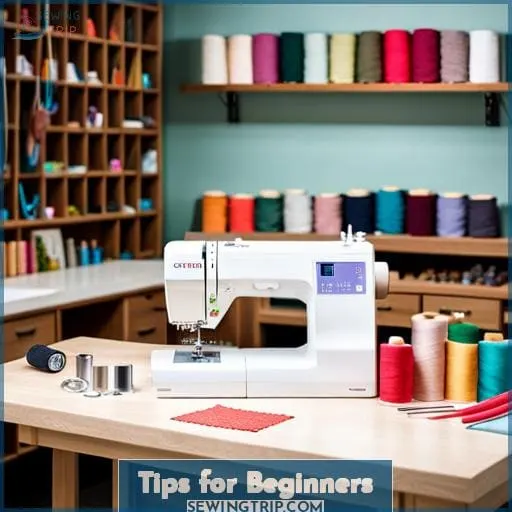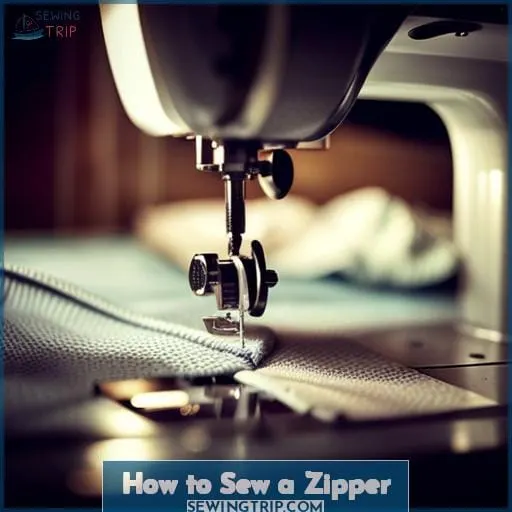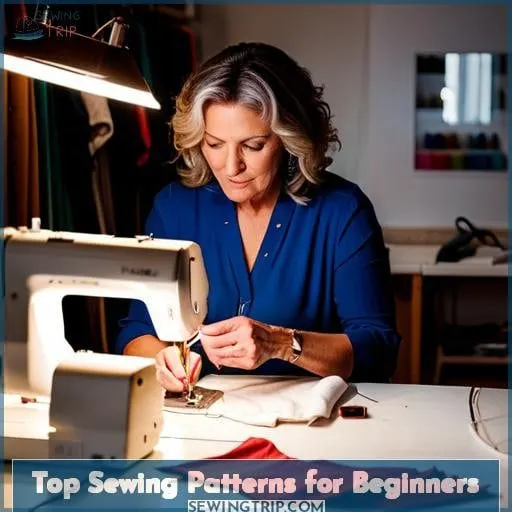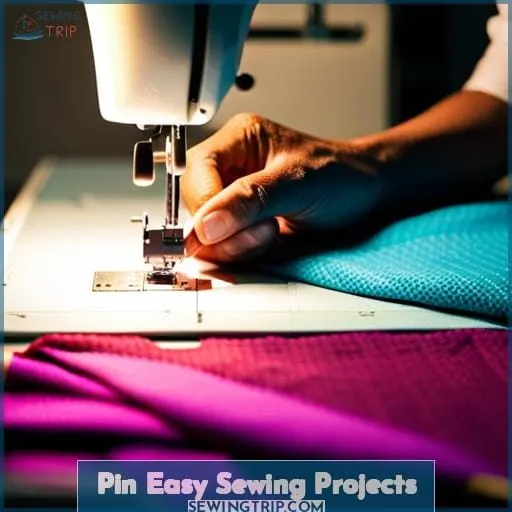This site is supported by our readers. We may earn a commission, at no cost to you, if you purchase through links.
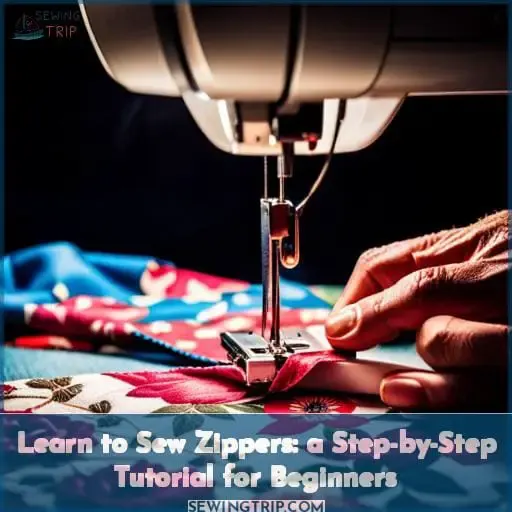 Ready to master sewing zippers? Whether you’re tackling your first zipper project or looking to take your sewing skills up a notch, this comprehensive tutorial has got you covered.
Ready to master sewing zippers? Whether you’re tackling your first zipper project or looking to take your sewing skills up a notch, this comprehensive tutorial has got you covered.
We’ll start with sewing basics – from machine settings to stitching straight lines. Then it’s on to beginner-friendly projects like totes, quilts, and even clothing.
Zippers aren’t as tricky as they seem. Follow step-by-step lessons on inserting zippers into everything from pouches to jumpsuits.
Dig into live tutorials, top patterns, and pro tips. Before you know it, you’ll feel empowered to sew zippers with confidence. Who knew learning a new skill could be so fun? With the right guidance, you can master even the trickiest techniques.
So grab your machine and let’s get sewing!
Table Of Contents
Key Takeaways
- Master straight zippers, curved zippers, and invisible zippers.
- Use the appropriate type of zipper for different projects (invisible zippers for clothing, metal teeth zippers for bags).
- Match the zipper to the project.
- Shorten overlong zippers by trimming above the stopper and reattaching the pull.
Sewing Basics
You’re eager to dive into sewing basics and build your skills one stitch at a time. Start by learning about fabric preparation, including pre-washing and pressing to remove creases.
Choose quality thread in a color that matches or contrasts nicely with your fabric. Become familiar with your sewing machine, including how to thread it properly, wind the bobbin, and adjust stitches.
Practice basic skills like cutting fabric straight with rulers and rotary cutters, pinning, and hand-basting to prepare pieces. Learn techniques for clean and tidy zipper installation, including invisible zippers.
Experiment with different seam finishes to prevent fraying. As your skills improve, move on to sewing simple items like pillows to practice constructing seams and darts.
With each project, focus on pressing as you go to keep pieces flat. Don’t be afraid to rip out stitches and try again until you’re satisfied.
Steady practice of sewing fundamentals will build expertise and confidence.
Beginner Sewing Projects
Looking to start sewing? Beginner-friendly projects like burp cloths, pillows, simple totes, and more will help you build essential skills. As your abilities grow, you can advance to dresses, backpacks, quilts, and other intermediate projects to create handmade gifts and decor.
Baby Projects
Start stitching a baby blanket with cheery fabric to get your little one cuddling up right quick. Sew receiving blankets, burp cloths, and diaper clutches for practical newborn nursery decor. Stitch a blanket binding or bias tape edge for durability. Try a bunny lovey or baby blanket for snuggly comfort.
Kid Projects
Gather fabrics like comic prints, swirling patterns, or bright solids for fun kid projects. Sew plushies, doll clothes, masks, capes, felt wallets. Make pillowcase dresses, ninja pouches, non-slip headbands, first wallets, toy car belts for your little superheroes.
Bags and Totes
Embrace this fantastic opportunity to nurture your creative spirit by crafting a personalized tote bag. Add structure with interfacing, pad straps for comfort, insert a lining for a polished look. Curve the zipper on top for a modern style. Zigzag edges so they don’t fray. Mind the allowances and sew right side up for a neater finished bag.
Home Decor
Embellish your home with handcrafted accents full of heart. Give rooms character with a simple doormat, fabric coasters, and custom pillowcases. Sew zippered pouches for storage. Try scrappy coasters, collage templates, and a table runner.
Use ladder stitch on projects. Learn bag sewing techniques like boxed corners. Homemade home decor gifts add a personalized touch.
Quilting
You’re eager to start quilting! Quilting allows you to transform fabric into cozy works of art.
Quilt Blocks
Step out of your comfort zone and learn some fun quilt blocks to add texture to your quilts. Try paper piecing sharp points or tiny pieces. Experiment with appliqué and stencils to layer shapes. Play with different batting to change the quilt’s drape. Mix up your fabric selection with tone-on-tone prints, batiks, solids, and novelty prints.
The options are endless for creative freedom. Channel your inner quilter spirit and let inspiration guide your next masterpiece.
Quilts
Start crafting your distinctive quilts with passion and enjoy seeing your delightful creations come alive.
- Choose traditional patterns like Log Cabin or Irish Chain to showcase vintage blocks.
- Select quality quilt batting and binding techniques for durability.
- Make baby blankets, pencil pouches, or zippered pouches to sell online.
With the right supplies and skills, you can design stunning quilts to treasure. Experiment with vibrant colors and varied textures to reflect your vision.
Clothing
If you’re looking to expand your sewing skills into making clothing, start with some easy, beginner-friendly projects. From baby clothes to kids’ outfits and even attempting more advanced designs like the Dana Jumpsuit covered in a recent tutorial, you’ll find a range of clothing patterns to help build confidence as you learn.
Baby Clothes
Gather up those tiny fabrics, for your little darling’s clothes will fill your heart with joy as you stitch. Choose soft, stretchy fabrics that are machine washable. Focus on neutral colors and simple designs like bibs and booties.
Check that zippers and snaps are secure. With love in every stitch, you’ll dress your baby in cozy handmade clothes.
| Type | Details |
|---|---|
| Knit Fabrics | Cotton, jersey, interlock |
| Woven Fabrics | Flannel, cotton, fleece |
| Closures | Snaps, zippers, Velcro |
| Prints | Solids, stripes, polka dots |
| Silhouette | Footed, kimono, raglan |
Kid’s Clothing
You’ll make their day by dressing them up in handmade creations tailored just for them. Sew simple clothes like t-shirts, dresses, and pants in fun prints. Add details like ruffles, appliques, and embroidery.
Make accessories too – headbands, hair clips, and purses. Match their interests – space, dinosaurs, and unicorns. Let them help pick fabrics and colors. They’ll love wearing special outfits made just for them.
DIY Jumpsuit
Before sewing the Dana jumpsuit’s zipper, check that you’ve got 2 2/3 yards of stretchy woven fabric – the blogger who made this cute retro holiday version was short just 14 inches with 3 yards!
- Cut fabric on the cross grain for texture.
- Remove seam allowance where possible.
- Use a zigzag stitch on most seams.
- Straight stitch shoulders and facings.
- Draft and add a neckline facing.
You can make this fun, retro holiday jumpsuit even as a beginner. Follow along with the video tutorial on inserting the zipper into the Dana pattern. Customize it by drafting your own neckline facing and adding design details like a V-neck, wrap ties, or removing the patch pockets.
With some clever layout, you can make it work with limited yardage too. Sewing the Dana jumpsuit will let your creative spirit shine.
Live Tutorials
Let’s get sewing! Dive into a live ocean quilt tutorial series and 30 days of zippers project to boost your skills. Follow step-by-step with an instructor in real-time, ask questions, and learn techniques to make quilts and bags.
Ocean Quilt
Follow along to create an amazing ocean quilt in the latest live tutorial! Assemble various shades of blue fabric to resemble waves and foam. Apply lightweight interfacing to the back for added stability. Use silver thread to topstitch around each block, adding a shimmering effect like light on the sea.
Seam it all together and then attach a hanging sleeve to showcase this stunning ocean quilt artwork in your home.
30 Days of Zippers
Sew up your zipping skills by laughing at the 30 Days of Zippers challenge! Ain’t nobody got time for that many zips.
- Install zippers like a pro with easy tutorials.
- Master straight, curved, and invisible zips.
- Make trendy tops, dresses, and bags.
- Laugh at zipper fails and share your wins.
- Get inspiration from zipper samples.
Zippers let you make pencil pouches, aprons, and totes. Practice on lunch sacks first. Then show off your skills on a trendy circle tote or beach bag. Zippers aren’t scary with the right teacher.
Tips for Beginners
Moving from live video tutorials to fundamental skills is an exciting step for any beginner. As intimidating as learning to sew may feel, starting simple is the key. With some basic tools and supplies, you’ll be creating in no time.
Focus first on these essential beginner tips:
- Print out PDF patterns and read all instructions before starting. Having detailed steps will prevent mistakes.
- Invest in quality scissors suited for fabric and keep blades sharp. This makes cutting fabric easy and precise.
- Learn to properly press with an iron to flatten seams and add crisp edges. Proper pressing makes projects look professional.
- Practice hand sewing techniques like running stitch and whip stitch. Useful for closing up openings and hemming projects.
- Use a tracing wheel and tracing paper to accurately transfer pattern markings onto fabric.
With fundamental skills like these, beginners can tackle projects like the awesome ocean quilt, felt earbud pouches, and even the 30 days of zippers series.
How to Sew a Zipper
You’ll be tickled pink when you learn the slick trick for neatly stitching in a zipper on your next fab project.
- Pick the right zipper length and type for your project.
- Cut the zipper opening and fabric straight using a rotary cutter and ruler.
- Pin or baste the zipper in place, right sides together.
- Sew slowly and carefully up to the slider, backstitching at the ends.
- Press with an iron, topstitch evenly on each side.
Installing a zipper takes practice, but once you get the hang of it, you’ll have professional-looking results. Go slow, use fabric bookmarks to avoid shifting, and don’t get frustrated if the thread breaks.
How to Make a Makeup Pouch
Let’s be real, girlfriend – this cute lined makeup pouch is your ticket to a glam getaway.
- Use a zipper at least 1 longer than the pouch opening for easier installation. Make sure to reinforce the ends!
- Use wipeable, stain-resistant fabrics like vinyl or laminated cotton. Add a fashionable print for style.
- Try a stretchy lining for more give when storing bulky items. Use interfacing on the outer fabric for structure.
Achieve makeup organization bliss with this DIY pouch. Choose fun fabrics and custom sizes for all your beauty needs. Spend time hand stitching the lining and admiring your creation. Your essentials have never looked – or felt – so good.
Top Sewing Patterns for Beginners
Great job picking a beginner-friendly pattern like the Dana Jumpsuit, since the simple lines and comfortable fit make it perfect for learning skills while building confidence in your abilities.
Some top sewing patterns for beginners are pillow covers, pouches, totes, and simple clothes.
Try starting with a square pillow cover or fat quarter pillow to learn basic construction.
Move to small starter projects like stitching an ice cream cone or other softie.
Sew a pouch or tote to practice zippers, lining, and straps before tackling a bag.
Choose knit binding on a quilt or add patch pockets and ruffles to clothes for interest.
Focus on the fun of creating, not perfection.
Simple, satisfying projects build skills and confidence to empower your sewing journey.
Pick patterns you love to make items for yourself, family, and friends.
Each new technique learned prepares for the next adventure in sewing.
Pin Easy Sewing Projects
Pin up some quick ‘n easy beginner projects to get your sewing skills going.
- Easy Hand Sewing: Start with hand sewing by making a simple st■ animal or doll using felt.
- Basic Patchwork Blocks: Patchwork quilts allow you to build skills with basic squares and rectangles.
- Paper Piecing Tutorial: Achieving precise points and shapes is possible, even for beginners, with paper piecing.
- Soft Plushie Making: Sew super cuddly plushies like monsters, animals, or your own design using furry fabrics.
- Zip Pouch Pattern: Whip up a handy pouch for everyday use. Install a zipper and add fun trims or pockets.
Start simple, be creative, and have fun watching your sewing improve project by project.
Frequently Asked Questions (FAQs)
What type of zipper is best for clothing versus bags and pouches?
For clothing, an invisible zipper gives a clean finish. For bags, a zipper with metal teeth is durable. A separating zipper allows full access to contents. Overall, match the zipper type to the project, considering strength, flexibility, visibility, and function.
How do I sew an invisible zipper?
Align the invisible zipper coils behind the fabric edges. Pin them in place. Sew close to the teeth on each side, starting from the bottom and moving to the top. Flip the zipper and press the seams. Topstitch near the edge, making sure to backstitch at the ends.
My zipper is stuck – how can I fix it?
First, check for anything stuck in the teeth. Then, rub wax or bar soap along the zipper to lubricate it. If that doesn’t work, use pliers to gently realign any bent teeth. Finally, replace the slider if it’s damaged.
Moving it slowly back and forth a few times can also help loosen a stuck zipper.
How do I shorten a zipper that is too long?
You’ll need to shorten the zipper teeth to fit your project. Carefully trim the excess zipper tape above the stopper using sharp scissors. Then reattach the new zipper pull and slide it on to ensure it still glides smoothly.
What needle and thread should I use when sewing in a zipper?
Use a regular or microtex sharp needle and all-purpose thread when sewing in a zipper. Set the stitch length to 5-3mm. Take your time and go slowly to achieve the cleanest stitching possible.
Conclusion
You’re almost at the end of this sewing adventure! We’ve walked through sewing basics, fun beginner projects, tips for starting out, and how to sew on a zipper. Now it’s time to take your new skills and create something amazing. Head to the sewing room, gather your fabric and notions, and let your creativity flow.

